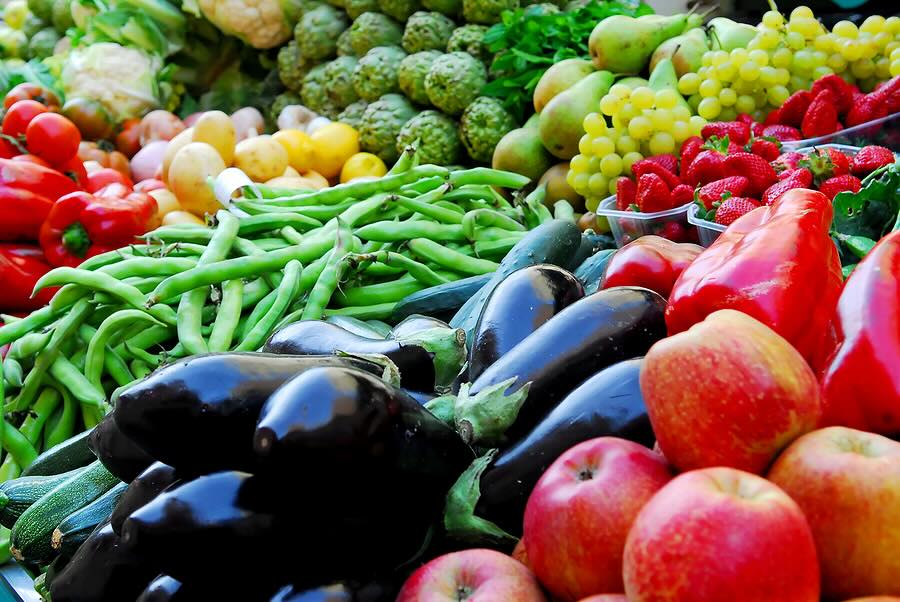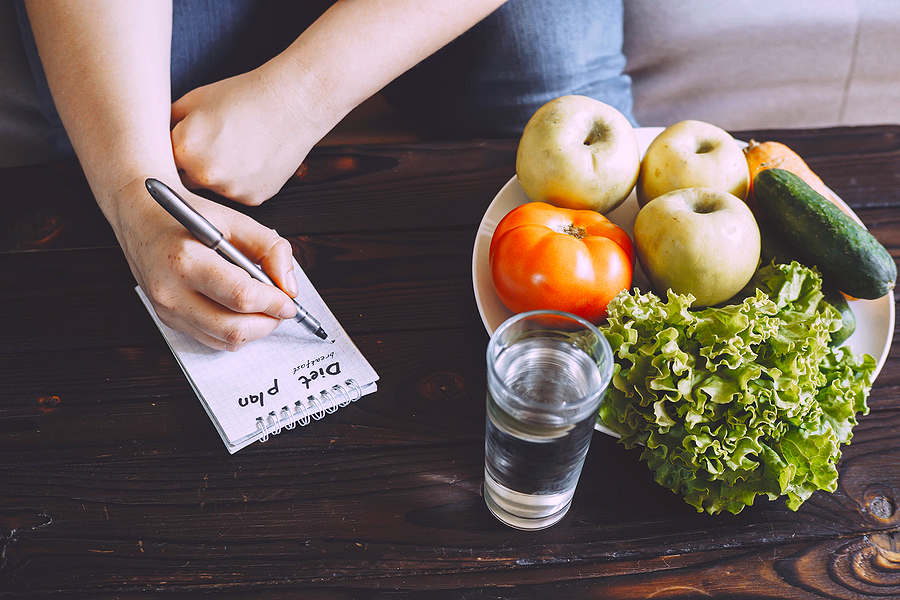Updated: July 21, 2025
- Non-organic produce is often covered in chemical residue that can seriously impact your health.
- Research shows adverse impacts of organophosphates and neonic pesticide, which are on a wide range of crops in the U.S.
- Organic growing practices keep your fruits and vegetables free of synthetic chemicals.
- Samples of produce tested by the Environmental Working Group showed residue of 265 distinct pesticides.
- The EWG publishes two valuable lists: the dirty dozen (produce with the most pesticides) and the clean 15 (produce with the least amount of pesticides).
- Try my tips for ensuring you are eating the safest, healthiest produce possible.
There’s nothing better than biting into a fresh peach, juice dripping down your chin, a burst of sweetness waking up your taste buds. Or eating berries by the handful at a summer picnic, or filling your plate with a crisp fresh salad. Can you tell how much I love fresh produce, especially this time of year? Summer brings so many delicious choices that healthy eating is easy!
My plate is typically filled with more vegetables than anything else year round. I like dessert as much as the next person, and sweet fresh fruit is an amazing option that doesn’t send me spiraling down into a sugar crash later.
What I don’t love, however, are the chemicals that can be left behind by modern agricultural practices. When I eat produce, I want the nutrients that boost my health, not synthetic pesticide residue that can leave me feeling lousy. That’s why I choose organic produce whenever I can.
With so many factors impacting our health, doesn’t it make sense to control the things we are able to? We can’t change what’s in the air around us, but we can choose what food we put into our bodies. When produce is certified organic, that means you can be confident that you are getting the nutrients and minerals without all the synthetic chemicals. Let’s take a closer look at what some of those chemicals might be.
Did you know you were consuming these chemicals?
There are too many chemicals used in modern agriculture to detail them all in one article. And some of these don’t show up on produce – or they simply aren’t tested for. There’s so much research that still needs to be done, but research takes time.
I can tell you about some of the most common chemicals that we do have information on. Let’s start with organophosphates.
This is the group of insecticides most commonly used, on a wide range of produce including apples, nectarines, peaches and so much more. They are used so often because they are very effective at keeping insects away from crops. But what are they doing to humans?
Because these substances work by attacking enzymes that control nerve signals, there are a range of nasty symptoms that can be experienced by high exposure, including dizziness, nausea and vomiting, breathing problems, and in more severe instances even seizures or neuropathy.
Not only that, but a study conducted by the Centers for Disease Control found that children with leukemia had high levels of organophosphates in their bodies.
And then there’s the neonic pesticides – which have been recently banned in the European Union (joining several other banned pesticides), but are found on one-fourth of samples of US cherries, watermelons and strawberries, and one half of tested samples of potatoes, spinach and lettuce, according the the Environmental Working Group.
The use of neonics not only kills bees and other insects vital in pollinating crops, but some studies indicate that exposure to neonics could be harmful to children and developing fetuses.
Why choose organic?
I hear a lot of controversy over whether eating organic really matters. Those who say it doesn’t will argue that the levels of exposure are so low that they don’t pose a real risk. But I think any exposure is potentially too much — we simply don’t know. And since there are so many things in our environment that we can’t control, why not make the safest choice whenever possible?
While the USDA reports that more than 99 percent of food samples tested showed levels far below what has been determined by the EPA to be safe, it’s important to remember that we are all unique individuals. So for some people, any exposure might be too much. And then there’s the concern about accumulation over time. These chemicals may build up in your body tissues, creating problems long after you’ve eaten that apple. In fact, one study showed that adults following an all organic diet had 90% less pesticides in their bodies! That’s a significant difference. Though the study was tiny, and more research is certainly needed, that drop is significant enough to make me think twice.
There is quite a bit of evidence that shows a correlation between pesticides and adverse health effects, particularly among people who live or work around pesticides. Of course their exposure is higher than the average person gets through their diet, but knowing that there’s evidence that these chemicals can cause health problems is reason enough for me to avoid them whenever I can. We just don’t have the long-term data available – and I’d rather be safe than sorry!
You’ll also hear that organic farming does use pesticides – and that is true. The difference, however, is that they use naturally occurring compounds, not synthetic pesticides. And organic farmers are also more likely to use creative methods to ward off pests, like sticky traps, hot pepper mixes, or even introducing other insects like ladybugs and beetles to help control insects that damage plants.
Given all the evidence, I think it’s wise to choose organic if you can. Especially for the produce that’s been found to contain the highest levels of pesticides. Let’s take a look at what those are.
Which Fruits and Vegetables Have the Most Chemicals?
The Environmental Working Group has spent the time analyzing information from USDA testing of conventionally grown fruits and vegetables so you don’t have to. Their Shopper’s Guide to Pesticides in Produce, updated annually, will help you know which produce contains the most pesticides – making them most important to buy organic. They’ll also let you know which conventionally grown produce might be fine. And if you’re looking for a very quick reference, take a look at their “Dirty Dozen” and “Clean 15” lists.
The EWG 2025 analysis revealed that over 95 percent of the fruits and vegetables on their dirty dozen list contained pesticide residues – even after washing and/or peeling the produce! In all produce tested, 265 different pesticides were found (203 on dirty dozen choices). Does that startle you? It should! But don’t give up hope of finding great produce that doesn’t have pesticides without going broke. Sixty percent of the samples of fruits and vegetables on the clean 15 list had no detectable pesticides. Those that did had fewer different pesticides and at lower amounts than the dirty dozen.
That’s why these lists are so handy – they’ll tell you in a glance which conventionally grown produce you can buy with confidence that you won’t be exposing yourself or your family to dangerous chemicals. Let’s take a closer look at each list.
The Dirty Dozen
This list is crucial in knowing which fruits and vegetables contained the highest pesticide load. Each one tested positive for not just one, but multiple different pesticides along with having higher concentrations than other produce.
The 2025 Dirty Dozen list, in order from highest contamination to lowest, is: spinach; strawberries; kale, collard and mustard greens; grapes; peaches; cherries; nectarines; pears; apples; blackberries; blueberries; and potatoes. And although they didn’t make the top twelve this year, the EWG added these “plus” vegetables: bell and hot peppers; and green beans.
Of these fruits and vegetables, 96% of samples had pesticides on them. A total of 203 different pesticides were found on these 12 items, and some samples from all except cherries showed over 50 pesticides. Each of the dozen, with the exception of potatoes, showed an average of four pesticides; potatoes had two.
And though there are two new types of produce on the list this year (potatoes and blackberries), the rest of the list is very similar to recent years. So even if you can’t afford to buy organic everything, these twelve products are a good place to start.
The Clean Fifteen
Now are you ready for some good news? The items on the Clean Fifteen list contained relatively few pesticides, and testing showed low concentrations of pesticide residues.
These fruits and vegetables are: pineapples, sweet corn(fresh and frozen), avocados, papaya, cabbages, onions, frozen sweet peas, papayas, onions, asparagus, cabbage, watermelon, cauliflower, bananas, mangoes, carrots, mushrooms, and kiwi.
Almost 60 percent of the samples in the clean 15 had no detectable pesticide residue. None of the top six had more than 3 pesticides, and only 16% of all samples contained residue from two or more pesticides. Avocado, papaya, pineapples, onions and sweet corn had the lowest rankings, including overall toxicity. Cauliflower and bananas joined the list this year, with bananas being among the produce with the lowest overall toxicity ranking.
So as you can see, there are plenty of delicious options that you won’t necessarily need to purchase organic. With the items on that list, you could make a great fruit salad or stir fry without having to worry. And with avocados topping the list, I say bring on the guacamole!
How can I avoid unwanted chemicals and enjoy my produce?
Buying organic produce can be expensive. And sometimes, it’s hard to find organic varieties of what you’re looking for at your regular supermarket. When you’re on a limited budget, or don’t want to spend a lot of extra time running to specialty markets, try these tips to keep chemical consumption to a minimum.
Do your research and know which are more likely to contain pesticides.
I just walked you through the EWG lists, but this information is easy to find online if you forget. You can even take a picture with your phone, or print out the lists and keep them in your wallet for quick reference. Refer to the lists when meal planning and find or create great, healthy, pesticide free recipes that use the clean fifteen.
Wash thoroughly and/or peel fruits and vegetables.
Even though residue was found on washed and peeled produce, it’s still good practice to wash your fruits and vegetables before consuming to prevent foodborne illness – and rinse away as much of the pesticides as you can.
According to the CSE, washing produce with 2% of salt water will remove most of the contact pesticide residues that normally appear on the surface of the vegetables and fruits. Almost 75 to 80 percent of pesticide residues are removed by cold water washing.
Peeling will reduce exposure, but you won’t be getting the valuable nutrients that the skin contains, so weigh out the pros and cons before peeling.
Buy in-season produce from local sources
When you are buying produce at a Farmers Market you can ask the farmers about their growing practices. Produce that’s in season and grown locally won’t contain chemicals meant to make it look better or stay fresh longer either!
Choose organic varieties of the produce you eat more often
Because the biggest risk comes from potential long-term buildup of chemicals consumed regularly, if you eat a specific type of fruit or vegetable every day, that’s a good place to start.
Buy store brands or bulk organic products
You can save yourself some money if you look for the store brand organic products, instead of the pricey private labels. If there are things you eat a lot of — like apples, for instance – look at box stores for large bags to stock up.
Don’t avoid produce – even if you can only buy conventional!
It’s important to note that it’s far more damaging to your health to stop eating fruits and vegetables if you can’t afford to buy organic. Fruits and vegetables – conventional or organic – offer so many important nutrients that you can’t get elsewhere. Although I prefer to avoid exposure to man made chemicals any time I can, I understand the difficulty pricey organics can pose for the average American. You won’t get many nutrients from processed, packaged foods and these contain some pretty nasty chemicals themselves! Non-organic fruits and vegetables are certainly a better option. At least the valuable nutrients balance out the exposure to chemicals!
Awareness is the first step to avoiding unwanted chemicals in your fruits and vegetables
You may never have even considered that fruits or vegetables could contain harmful chemicals that build up in your body. Now you know, so you can be aware of the risks and pay attention to how your own body reacts to specific foods. Making a slow transition to organic produce – especially locally grown – can keep you healthy and chemical free. Your body will thank you!







